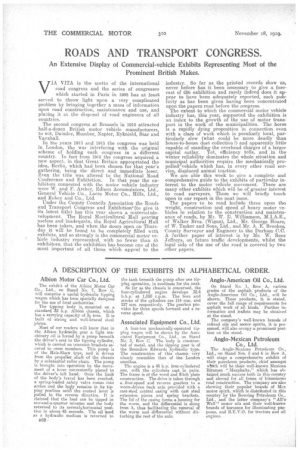ROADS AND TRANSPORT CONGRESS.
Page 12

If you've noticed an error in this article please click here to report it so we can fix it.
An Extensive Display of Commercial-vehicle Exhibits Representing Most of the Prominent British Makes.
VIA VITA is the motto of the international road congress and the series of congresses which started in Paris in 1908 has at leas served to throw light upon a very complicated problem by bringing together a mass of information upon road construction, maintenance and use, and placing it at the disposal of road engineers of all countries.
The second congress at Brussels in 1910 attracted half-a-dozen British motor vehicle manufacturers, to wit, Daimler, Humber, Napier, Ryknield, Star and Vauxhall.
In the years 1912 and 1915 the congress was held in London, the war interfering with the original scheme of holding each congress in a different country. In fact from 1915 the congress acquired a new aspect, in that Great Britain appropriated the idea, Berlin, which had been chosen for that year's gathering, being the direct and immediate loser. Even the title was altered to the National Road Conference and Exhibition. In that year the exhibitors connected with the motor vehicle industry were W. and F. Archer Edison Accumulators, Ltd., General Vehicle Co., L'acre Motor Co., Hills, Ltd., and Robey and Co., Ltd. Under the County Councils Association the Roads and Transport Congress and Exhibition(to give it its latest title) has this year shown a material adeveIopment. The Royal Horticultural Hall proving useless and inadequate, the Royal Agricultural Hall has been taken, and when the doors open on Thursday it will be found to be completely filled with exhibits, and so strongly is the commercial motor vehicle industry represented, with no fewer than 45 exhibitors, that the exhibition has become one of the most important of all those which appeal to the
industry. So far as the printed records show us, never before has it been necessary to give a forecast of tire exhibition and rarely indeed does it appear to have been adequately reported, such publicity as has been given having been concentrated upon the papers read before the congress. The extent to which the commercial motor vehicle industry has, this year, supported the exhibition is an index to the growth of the use of motor transport in the work of the municipalities. The horse is a rapidly dying proposition in connection even with a class of work which is peculiarly local, particularly slow (what could be more deadly than house-to-house dust collection?) and apparently little capable of standing the overhead charges of a larger capital outlay. Yet, efficiency tells, and in the winter reliability dominates the whole situation and municipal authorities require the mechanically propelled'vehicle which has, in every other road service, displaced animal traction. We are able this week to. give a complete and comprehensive guide to the exhibits of particular interest to the motor vehicle movement. There are many other exhibits which will be of greater interest to road surveyors. These we will briefly touch upon in our report in the next issue. The papers to be read include three upon the weight, construction and speed. of heavy motor vehicles in relation to the construction and maintenance of roads, by Mr. W. D. Williamson, M.I.A.E., of Walker Broa. (Wigan), Ltd., Mr. George Hoare, of W. Tasker and Sons, Ltd., and Mr. A. E. Brookes, 'County Surveyor and Engineer to the Durham C.C. A further paper of interest is by Mr. W. Rees Jeffreys, on future traffic developments, whilst the legal side of the use of the road is covered by two other papers.




























